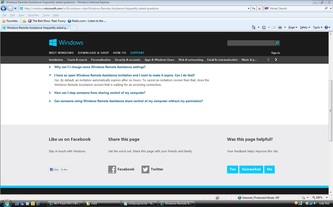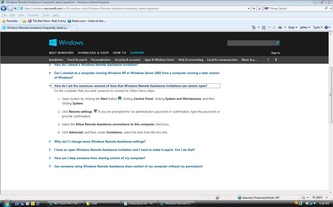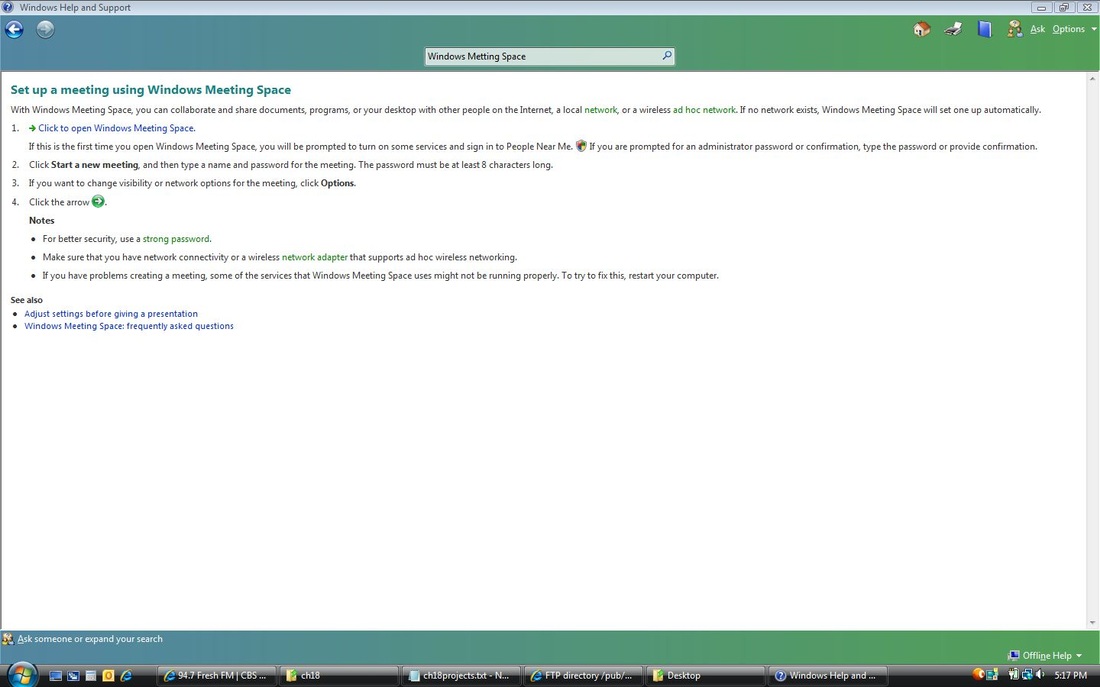Project 18-1
While connected to the Internet or another TCP/IP network, answer these questions:
1. What is your current IP address?
192.168.1.79
2. Release and renew your IP address. Now what is your IP address?
192.168.1.79
3. Are you using dynamic or static IP addressing? how do you know?
Dynamic, I set my IP to automatic
4. What is your adapter address for this connection?
00-1F-3A-20-C3-0D
5. What is your default gateway IP address?
192.168.1.254
6. What response do you get when you ping the default gateway?
C:\Users\amanda>ping 192.168.1.254
Pinging 192.168.1.254 with 32 bytes of data:
Reply from 192.168.1.254:
bytes=32 time=3ms TTL=255
Reply from 192.168.1.254: bytes=32 time=115ms
TTL=255
Reply from 192.168.1.254: bytes=32 time=67ms TTL=255
Reply from
192.168.1.254: bytes=32 time=1ms TTL=255
Ping statistics for 192.168.1.254:
Packets: Sent = 4,
Received = 4, Lost = 0 (0% loss),
Approximate round trip times in
mili-seconds:
Minimum = 1ms, Maximum = 115ms, Average =
46ms
While connected to the Internet or another TCP/IP network, answer these questions:
1. What is your current IP address?
192.168.1.79
2. Release and renew your IP address. Now what is your IP address?
192.168.1.79
3. Are you using dynamic or static IP addressing? how do you know?
Dynamic, I set my IP to automatic
4. What is your adapter address for this connection?
00-1F-3A-20-C3-0D
5. What is your default gateway IP address?
192.168.1.254
6. What response do you get when you ping the default gateway?
C:\Users\amanda>ping 192.168.1.254
Pinging 192.168.1.254 with 32 bytes of data:
Reply from 192.168.1.254:
bytes=32 time=3ms TTL=255
Reply from 192.168.1.254: bytes=32 time=115ms
TTL=255
Reply from 192.168.1.254: bytes=32 time=67ms TTL=255
Reply from
192.168.1.254: bytes=32 time=1ms TTL=255
Ping statistics for 192.168.1.254:
Packets: Sent = 4,
Received = 4, Lost = 0 (0% loss),
Approximate round trip times in
mili-seconds:
Minimum = 1ms, Maximum = 115ms, Average =
46ms
Project 18-2
A technician needs to know how to find information he needs to help users and troubleshoot problems. Using sources you can trust, answer the following. List your source of information for each question:
http://windows.microsoft.com/is-IS/windows-vista/Windows-Remote-Assistance-frequently-asked-questions
1. What are the steps to cancel a Remote Assistance invitation before it
expires?
See picture
2. What are the steps to extend a Remote Assistance invitation from six to 12
hours?
See picture
3. What are the steps to start a Remote Assistance session when using Windows Messenger?
4. What is the time until expiration for an invitation when using Windows
Vista? When using Windows XP?
Project 18-3
Verizon is currently offering an alternative to DSL and cable modem for broadband Internet access. FiOS is a fiber-optic Internet service that uses fiber-optic cable all the way to your house for both your residential telephone service and Internet access. Search the Web for answers to these questions about FiOS:
1. Give a brief description of FiOS and how it is used for Internet
access.
FiOS offers several service tiers that are available individually, but are offered at significant discounts when combined in a bundle. Although all current tiers are available nationwide, price varies between markets and some legacy tiers are available only in select markets. The tiers are distinguished by data transmission speed measured in Mbit/s downstream and upstream. Six different offerings are available: [4]
3/1 – offered as an upgrade to FiOS for DSL customers.
15/5 – available as individual or bundle tier.
25/25 – available as individual or bundle tier.
35/35 – a bundled tier only.
50/25 – available as individual or bundle tier.
75/35 – available as individual or bundle tier.
150/35 – available individually and with bundles in some markets; it requires a GPON optical network terminal, which is only available in GPON, deployed central offices.
300/65; [5] Standalone only; requires a GPON optical network terminal as well as a gigabit broadband home router.
Legacy speed tiers include: 5/2, 10/2, 15/2, 15/15, 20/5, 20/20, 25/15, 30/5, 30/15, and 35/20.
2. What downstream and upstream speeds can FiOS support?
50/25 Mbps
3. When using FiOS, does your telephone voice communication share the
fiber-optic cable with Internet data?
yes
4. What does Verizon say about FiOS cabling used for television?
Verizon's broadcast video service is not IPTV (Internet Protocol television),
unlike AT&T's U-verse product. However, video on demand content and
interactive features, such as widgets and programing guide data, are delivered
using IPTV-based technology. The majority of content is provided over a standard broadcast video signal that carries digital QAM content up to 870 MHz This broadcast content originates from a Super Head-End, which sends the signal to a Video Hub Office for distribution to FiOS TV customers. [6]
From the Optical Network Terminal (ONT) at the subscriber premise, the RF
video is delivered with a coaxial connection to typically a FiOS set-top box
that handles both RF and IPTV video. Interactive services such as VOD and
widgets are delivered by IP and are only accessible through use of a FiOS
set-top box and a Verizon-supplied router. The router supports multimedia (MOCA) and provides the set-top boxes with programming guides and all SD channels, but high definition content (beyond local HD channels which are in clear QAM) requires HD equipment like a FiOS HD set-top box/DVR or a CableCARD-supporting device, such as TiVo. In 2008, Verizon ceased carrying analog television signals in parallel with digital channels, meaning televisions without a QAM tuner or a set-top digital adapter received no signal
5. Is FiOS available in your area?
No
Project 18-4
Practice using FTP by downloading the latest version of Firefox, a Web browser, using three different methods. Do the following:
1. Using your current browser go to Mozilla Web site at mozilla.org and download the latest version of Firefox. What is the version number? What is the name of the downloaded file? In what folder on your hard drive did you put the file?
Firefox version: 16.0.2
File name: Firefox Setup 16.0.2.exe
Downloaded to: Desktop
2. Using your current browser as an FTP client, locate the same version of
Firefox and the dame file at the Mozilla FTP site ftp.mozilla.org and download it to your PC What is the path to the Firefox file on the FTP site? In what folder on your hard drive did you put the file?
ftp://ftp.mozilla.org/pub/mozilla.org/firefox/releases/stub/file
path: C:\Users\amanda\Desktop
Project 18-5
Using the Windows Help and Support window, search for information on Windows Metting Space. Describe the tool. when would you want to use it? what can you do with Windows Meeting Space? Set up and test the tool with a friend on a network connection.
See picture.
A technician needs to know how to find information he needs to help users and troubleshoot problems. Using sources you can trust, answer the following. List your source of information for each question:
http://windows.microsoft.com/is-IS/windows-vista/Windows-Remote-Assistance-frequently-asked-questions
1. What are the steps to cancel a Remote Assistance invitation before it
expires?
See picture
2. What are the steps to extend a Remote Assistance invitation from six to 12
hours?
See picture
3. What are the steps to start a Remote Assistance session when using Windows Messenger?
4. What is the time until expiration for an invitation when using Windows
Vista? When using Windows XP?
Project 18-3
Verizon is currently offering an alternative to DSL and cable modem for broadband Internet access. FiOS is a fiber-optic Internet service that uses fiber-optic cable all the way to your house for both your residential telephone service and Internet access. Search the Web for answers to these questions about FiOS:
1. Give a brief description of FiOS and how it is used for Internet
access.
FiOS offers several service tiers that are available individually, but are offered at significant discounts when combined in a bundle. Although all current tiers are available nationwide, price varies between markets and some legacy tiers are available only in select markets. The tiers are distinguished by data transmission speed measured in Mbit/s downstream and upstream. Six different offerings are available: [4]
3/1 – offered as an upgrade to FiOS for DSL customers.
15/5 – available as individual or bundle tier.
25/25 – available as individual or bundle tier.
35/35 – a bundled tier only.
50/25 – available as individual or bundle tier.
75/35 – available as individual or bundle tier.
150/35 – available individually and with bundles in some markets; it requires a GPON optical network terminal, which is only available in GPON, deployed central offices.
300/65; [5] Standalone only; requires a GPON optical network terminal as well as a gigabit broadband home router.
Legacy speed tiers include: 5/2, 10/2, 15/2, 15/15, 20/5, 20/20, 25/15, 30/5, 30/15, and 35/20.
2. What downstream and upstream speeds can FiOS support?
50/25 Mbps
3. When using FiOS, does your telephone voice communication share the
fiber-optic cable with Internet data?
yes
4. What does Verizon say about FiOS cabling used for television?
Verizon's broadcast video service is not IPTV (Internet Protocol television),
unlike AT&T's U-verse product. However, video on demand content and
interactive features, such as widgets and programing guide data, are delivered
using IPTV-based technology. The majority of content is provided over a standard broadcast video signal that carries digital QAM content up to 870 MHz This broadcast content originates from a Super Head-End, which sends the signal to a Video Hub Office for distribution to FiOS TV customers. [6]
From the Optical Network Terminal (ONT) at the subscriber premise, the RF
video is delivered with a coaxial connection to typically a FiOS set-top box
that handles both RF and IPTV video. Interactive services such as VOD and
widgets are delivered by IP and are only accessible through use of a FiOS
set-top box and a Verizon-supplied router. The router supports multimedia (MOCA) and provides the set-top boxes with programming guides and all SD channels, but high definition content (beyond local HD channels which are in clear QAM) requires HD equipment like a FiOS HD set-top box/DVR or a CableCARD-supporting device, such as TiVo. In 2008, Verizon ceased carrying analog television signals in parallel with digital channels, meaning televisions without a QAM tuner or a set-top digital adapter received no signal
5. Is FiOS available in your area?
No
Project 18-4
Practice using FTP by downloading the latest version of Firefox, a Web browser, using three different methods. Do the following:
1. Using your current browser go to Mozilla Web site at mozilla.org and download the latest version of Firefox. What is the version number? What is the name of the downloaded file? In what folder on your hard drive did you put the file?
Firefox version: 16.0.2
File name: Firefox Setup 16.0.2.exe
Downloaded to: Desktop
2. Using your current browser as an FTP client, locate the same version of
Firefox and the dame file at the Mozilla FTP site ftp.mozilla.org and download it to your PC What is the path to the Firefox file on the FTP site? In what folder on your hard drive did you put the file?
ftp://ftp.mozilla.org/pub/mozilla.org/firefox/releases/stub/file
path: C:\Users\amanda\Desktop
Project 18-5
Using the Windows Help and Support window, search for information on Windows Metting Space. Describe the tool. when would you want to use it? what can you do with Windows Meeting Space? Set up and test the tool with a friend on a network connection.
See picture.



 RSS Feed
RSS Feed